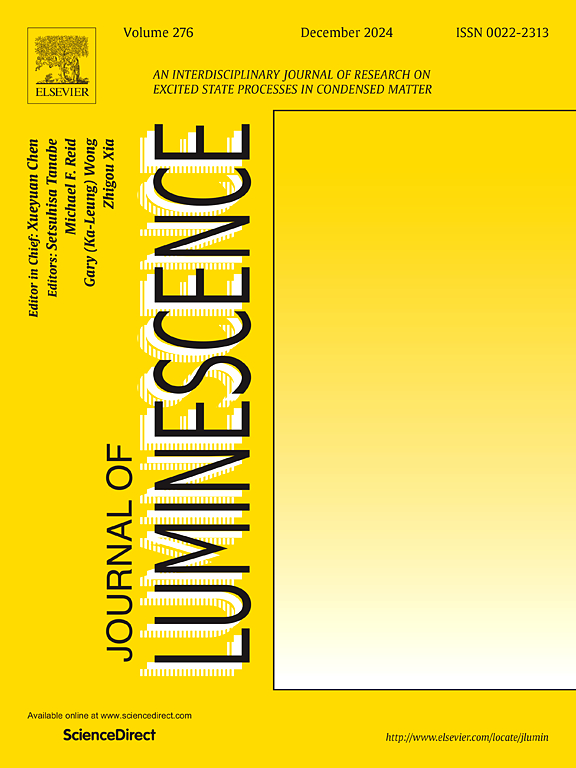High thermal stability Gd5-x-ySi2BO13:xTb3+, yEu3+ phosphors achieve color tunable emission through Tb3+-Eu3+ energy transfer
IF 3.3
3区 物理与天体物理
Q2 OPTICS
引用次数: 0
Abstract
A series of Gd5-xSi2BO13: xRE3+ (Tb3+, Eu3+, Tb3+/Eu3+) phosphors were successfully synthesized using high-temperature solid-state method. Color tunable single-phase phosphors were obtained through energy transfer between Tb3+ and Eu3+. The phase structure, luminescence characteristics, and energy transfer mechanism of the obtained fluorescent powder were systematically studied. The energy transfer (ET) process from Tb3+ to Eu3+ was determined to occur through exchange interactions. By changing the Tb/Eu doping concentration ratio, multi-color luminescence can be achieved under 377 nm light excitation, with emission colors adjusted from green and orange to red. The comprehensive emission intensity of Gd4.42Si2BO13:0.55Tb3+, 0.03Eu3+ at 150 °C was 87.73 % of that at room temperature, the activation energy is 0.20 eV, indicating good thermal stability. Finally, the potential applications of the samples in the fields of lighting and anti-counterfeiting were explored. Encapsulate the synthesized Gd4.42Si2BO13:0.55Tb3+, 0.03Eu3+ phosphors in commercial w-LEDs for actual performance testing. Ra is 90.6, CCT is 3441 K, and the light source performance is good. Using screen printing technology, Gd4.42Si2BO13:0.55Tb3+, 0.03Eu3+ phosphors were prepared into anti-counterfeiting ink, and optical anti-counterfeiting patterns were made on glass. The pattern will not be visible when placed in a white environment but will emit yellow and red fluorescence under 365 nm and 395 nm UV excitation, respectively. The results indicate that Gd5-x-ySi2BO13:xTb3+, yEu3+ is a multi-color tunable single-phase fluorescent powder with good luminescence performance and thermal stability, which can be applied in the field of ultraviolet excited w-LED and has potential application value in the field of optical anti-counterfeiting.
高热稳定性Gd5-x-ySi2BO13:xTb3+, yEu3+荧光粉通过Tb3+-Eu3+能量转移实现颜色可调发射
采用高温固相法成功合成了一系列Gd5-xSi2BO13: xRE3+ (Tb3+, Eu3+, Tb3+/Eu3+)荧光粉。通过Tb3+和Eu3+之间的能量转移,获得了可调颜色的单相荧光粉。系统地研究了所制备的荧光粉的相结构、发光特性和能量传递机理。确定了从Tb3+到Eu3+的能量转移(ET)过程是通过交换作用发生的。通过改变Tb/Eu掺杂浓度比,可以在377nm光激发下实现多色发光,发光颜色从绿色、橙色调整到红色。Gd4.42Si2BO13:0.55Tb3+, 0.03Eu3+在150℃时的综合发射强度是室温时的87.73%,活化能为0.20 eV,具有良好的热稳定性。最后,对样品在照明和防伪等领域的潜在应用进行了探讨。将合成的Gd4.42Si2BO13:0.55Tb3+, 0.03Eu3+荧光粉封装在商用w- led中进行实际性能测试。Ra为90.6,CCT为3441 K,光源性能良好。采用丝网印刷技术,将Gd4.42Si2BO13:0.55Tb3+, 0.03Eu3+荧光粉制备成防伪油墨,并在玻璃上制作光学防伪图案。该图案在白色环境中不可见,但在365 nm和395 nm的紫外线激发下分别发出黄色和红色荧光。结果表明,Gd5-x-ySi2BO13:xTb3+, yEu3+是一种具有良好发光性能和热稳定性的多色可调单相荧光粉,可应用于紫外激发w-LED领域,在光学防伪领域具有潜在的应用价值。
本文章由计算机程序翻译,如有差异,请以英文原文为准。
求助全文
约1分钟内获得全文
求助全文
来源期刊

Journal of Luminescence
物理-光学
CiteScore
6.70
自引率
13.90%
发文量
850
审稿时长
3.8 months
期刊介绍:
The purpose of the Journal of Luminescence is to provide a means of communication between scientists in different disciplines who share a common interest in the electronic excited states of molecular, ionic and covalent systems, whether crystalline, amorphous, or liquid.
We invite original papers and reviews on such subjects as: exciton and polariton dynamics, dynamics of localized excited states, energy and charge transport in ordered and disordered systems, radiative and non-radiative recombination, relaxation processes, vibronic interactions in electronic excited states, photochemistry in condensed systems, excited state resonance, double resonance, spin dynamics, selective excitation spectroscopy, hole burning, coherent processes in excited states, (e.g. coherent optical transients, photon echoes, transient gratings), multiphoton processes, optical bistability, photochromism, and new techniques for the study of excited states. This list is not intended to be exhaustive. Papers in the traditional areas of optical spectroscopy (absorption, MCD, luminescence, Raman scattering) are welcome. Papers on applications (phosphors, scintillators, electro- and cathodo-luminescence, radiography, bioimaging, solar energy, energy conversion, etc.) are also welcome if they present results of scientific, rather than only technological interest. However, papers containing purely theoretical results, not related to phenomena in the excited states, as well as papers using luminescence spectroscopy to perform routine analytical chemistry or biochemistry procedures, are outside the scope of the journal. Some exceptions will be possible at the discretion of the editors.
 求助内容:
求助内容: 应助结果提醒方式:
应助结果提醒方式:


